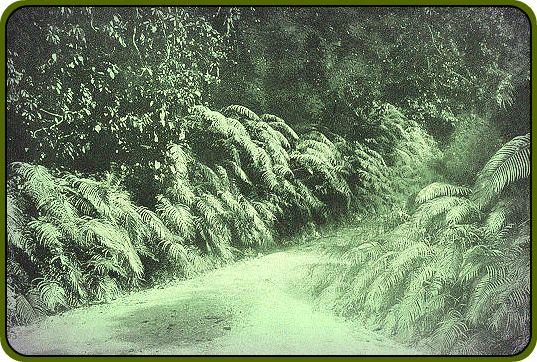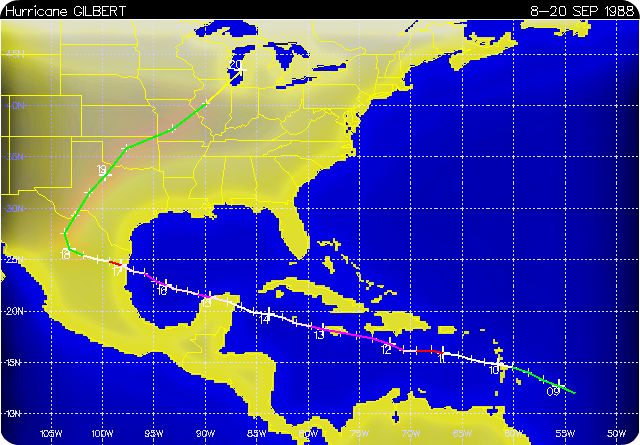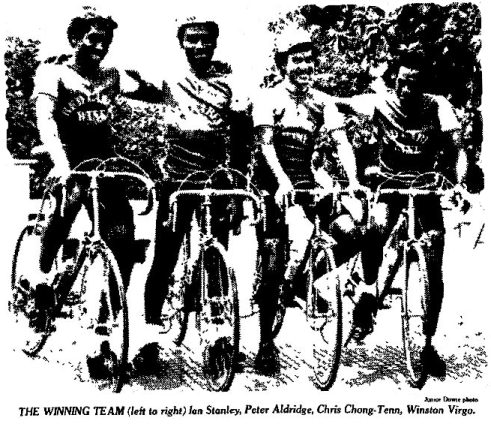
Can this irreplaceable treasure be saved?
Fern Gully threatened by erosion
BY GREEN LEAF
Jamaica's
unique, natural garden, Fern Gully, with
a
population of scores of fern species, a
few
bromeliads, aeroids and a canopy of
indigenous
trees, including the impressive
"Anchovy pear,”
is threatened by erosion
and toxicality. Human
vandalism is minimal.
Fern
Gully is well advanced to being a
disaster
area. Can this precious and famous
treasure be
saved? Is the Gardens Advisory
Committee aware
of impending loss, and if
so, what is this
Committee's proposal to
halt loss?
Deterioration proceeds at such a rate that within a
few years people will question why Fern
Gully was
so named. All that will
remain is a limestone ravine
bisected by
a narrow, serpentine road that links
verdant Walker's Wood and Ocho Rios.
Ocho
Rios and by extension the entire northcoast
is rapidly expanding as a vacation district
which stands to forever lose the
irreplaceable treasure of Fern Gully.
Not
the greatest expenditure of money nor skills
of dedicated gardeners could duplicate Fern
Gully. What
is the reaction to this threat? Do
horticultural societies and their related natural history companions or the Tourist Board care?
How
fatally doomed is Fern Gully as
demonstrated by comparing the present
appearance of this
gorge with a postal pictoral
card made,
I suspect, 50 or 60 years
ago by the
photographers, Cleary and Elliot,
in their series of
Jamaican beauty spots.
About that time too, the
Jamaican Post Office issued a similar set of scenic
postal
stamps. Both postcard and stamp show Fern
Gully inhabited by a species so luxuriant that a
man and buggy included in the
scene are barely
discernable.
Disaster
in Fern Gully is caused by inter-related
factors. They are motor traffic and
erosion.
Motor traffic intensifies wherever wealth, in this
case the wealth activated by the bauxite
industry,
results in distributed prosperity.
Fumes exhaled by
engines harm plant
life by fouling the atmosphere,
by overlaying plant parts (leaves, stems, exposed
roots) and soil with an adhesive film.
On
the film are deposited panicles of dust.
An
impenetrable coating is sealed on preventing
the plants from breathing. They suffocate
and
eventually die. Only the most
competitive survive.
Indeed, many scientists now
marvel that any plants
at all still live in Fern Gully.
A
secondary attack on Fern Gully vegetation is
vibration from vehicular traffic. This
weakens
soil layers, thereby discouraging and
disturbing
root anchorage. Thus the roots
become unable to
supply nutrients to plants.
Thirdly, Fern Gully has the enemy of erosion. The process in Fern Gully is maximised by that very factor of steep, damp limestone cliffs which originally induced the natural establishment of fern colonies.
The
Flora flood alerted the late Vernon
James,
then Superintendent of Parks and Gardens, to losses in Fern Gully. He utilised fallen trees as barriers and re-planted fern. The task lacked supervision. Workers concentrated on Roosevelt fern because it is abundant in that area. I urged Mr. James to save the nephrolepis and adiantum.
Even if they are replanted who
would care for
them, he objected. I
now realise that their spores
would not survive the toxic fumes.
In
the 16 years since, Fern Gully's denudement
continued. Among the notable casualties are
fern
allies and mosses which are among
the treasures of
Fern Gully.
The
total ecology is shattered. Could
Fern Gully
be rehabilitated by say closing
the road to motor
vehicular traffic and diverting this to the by pass?
Yet
that alone is insufficient Other agencies
are
essential. Very little time remains to
save Fern
Gully from complete wreck. Is
the Ministry of
Agriculture whose responsibility
is Fern Gully,
prepared to act on whatever recommendations
might be advanced by
the Gardens
Advisory
Committee?
For there are several practical alternatives to that of passively awaiting death in Fern Gully.
From the mail-bag:
FERN
GULLY: Thank you most sincerely for your
splendid article calling attention to
the dangers
that beset Fern Gully. Many
persons have
commented upon it yet none
of us know what could
be done by
citizens to protect this place from being
as you stressed, forever lost.
M.S. St. Ann's Bay.
I
am impressed by what you wrote about
the
destruction of Fern Gully. I, too,
have noticed that
it is sadly deteriorating
year after year. Surely the
citizens of
St. Ann and
especially those around
Ocho Rios who
benefit from this tourist attraction
should do something to halt destruction!
Of
course, all Jamaicans stand to lose if
Fern Gully
is destroyed, but it is Ocho Rios that would lose the
most.
CONCERNED. Montego Bay.
Daily Gleaner,
September 14, 1980
From the mail-bag:
FERN
GULLY: Let me add my own big Thanks
to
you for your moving article on the
impending loss of
Fern Gully. Several people
who read the article are
saying that it could not have been more timely.
Also,
do you know that hurricane Allen
additionally destroyed this beauty spot by rooting
out many trees with the result that the
ferns are
fully exposed to harsh daylight?
E. Brown, Port Maria, St. Mary.
probably the island's most famous,
of Fern Gully in the 1920s

and deal with some of the problems there.
FERN GULLY TO BE A NATIONAL PARK
Fern
Gully, in Ocho Rios, North-East St. Ann,
is to be made a national park by the Government,
at a cost of $1.9 million.
Included
in the project is a by-pass road from
Breadnut Hill. This will provide for the
blocking
off of vehicular traffic through
Fern Gully at a certain point. But the
detour would be arranged
in such a
close proximity to the scenic spot that
visitors using vehicles
would encounter no
problem walking to the
park from their transport. More . . .


Jamaica win 'Red Label' Cycling road race
Peter Aldridge the hero
The
Jamaica "A" team led by 21
-year-old Peter
Aldridge won the 4-stage "Red Label Wine"
International
Cycling Road race which ended
yesterday.
Yesterday. Aldridge added the icing to the cake
when he came in by a whisker in
front of Puerto
Rico's Ramon Rivera in
the 54-mile Ocho Rios
to Kingston final
leg in the extraordinary time
of 2
hours 55 minutes and 48 seconds
surmounting
the backbone of the island up Fern
Gully and the Mount Diablo range.
Virgo overthrows Aldridge in 58-mile road race
The
sprint for the finish was expected
some-where along the Fern Gully
descent, and it came as no surprise
when
Everton Brown broke the pcae and
sped forward. Chase was given by Aldridge,
followed by the main group. The
surprise
came when a tiring Aldridge caught up
with Brown, and Virgo,
in a well-calculated move, sprinted to leave
the others behind.
Kingston to Ocho Rios cycle race today
The
Kentucky Fried Chicken/Jamaica Amateur Cycling
Association (JACA) cycling season continues
this
morning with a 66-mile journey from Kingston to Ocho Rios. The race begins at 10:00.
Over
75 cyclists comprising senior and juniors
will hit the trail which should be
gruelling. The
race starts at the
Kentucky Fried Chicken Special store on King Street and ends at the Main Street branch in Ocho Rios.
Last
year's winner Winston Virgo from Montego
Bay will be hoping to retain his title. However, he will have stiff
competitions from champion rider Peter Aldridge, Franklyn Taylor, Patrick Grant, Lorenzo Murdock, and Michael Manderson.
The
cyclists will travel through the steep Mount
Diablo, and the winding rush of Fern
Gully. Young riders such as
Ricardo Housen,
Mark Collins, Kirk Catnott, could find the
journey taxing, and will probably have
difficulty
maintaining pace with the top 'A' Class riders.


from 'Jamaica Land We Love', Singer Jay's entry
for the Festival Song Contest, 1988

In mid-September 1988 Jamaica was hit head-on by its first major hurricane since Charlie in 1951. The online Gleaner archive is almost non-existent for the days after the hurricane hit, so the only comment about Gilbert's impact on Fern Gully that I have found, so far, comes from - mandevilleweekly.com:
'It still remains attractive with banks
of ferns and other plants forming a
canopy. Prior to the damage caused

by Hurricane Gilbert,
motor vehicles traversing Fern Gully would
need to use headlights at all
times but that is no longer the case.'
Presumably Gilbert had undone some of whatever good had been done by the restoration efforts in 1983-4, leaving Fern Gully to be described in the following decade in much the same despairing terms as in earlier decades.
In October 1990 Marjorie Stair complained about the road blocks:
. . . the particular road block was at the entrance to Fern Gully. The people had blocked the road because they claimed they had not received any water for several days. They chose the day that the tourist buses visit the area to block the road.
The irony of the situation was that I drove behind the truck which was taking water into the area, almost the full length Of Fern Gully. The minute the truck driver realised that the road was still blocked, was the minute he backed his (the National Water Commission truck) into an intersection, turned the truck around and went back whence he came with the water. Daily Gleaner, October 29, 1990
In the following year the Ocho Rios Chamber of Commerce tried once again to urge the preservation of surrounding environment:
Fern Gully: the value of which as a beauty spot Is being eroded by squatting and littering. Meanwhile, the destruction of plant species from exhaust fumes continues. The Chamber endorses a recommendation that an alternate route via Breadnut Hill be developed to ease the pressure on Fern Gully and that the attraction be cleared of all shacks and advertisements.
Daily Gleaner, December 7, 1991
Towards the end of 1992 three well-known Jamaicans added their voices to the cries of despair about Fern Gully - Norma Soas wrote an anguished article in the Daily Gleaner, which drew equally heart-felt responses from Desmond Henry and Morris Cargill. more >>>
Closing
Fern Gully
All lovers of Jamaica's natural beauty will applaud the move made recently in the Senate to
have the Fern Gully restored to something of its pristine attractiveness, by limiting its use as a
main road. The traffic which passes daily through this scenic gorge has taken a heavy toll of it,
rendering it more of an eyesore than a beauty spot.
There was a time when this picturesque natural garden of luxuriant ferns and other forest plants and trees was a delight to the eye and a balm to the senses. The canopy created by the
spreading overhead branches formed a natural screen through which the sunlight filtered in a pleasing pattern of light and shade. Descriptions of Jamaica's beauty never failed to include
Fern Gully as one of the country's prime natural attractions.
Today, very little of this pristine beauty remains. Men and machines have combined to bring virtual ruin to Fern Gully. Much of the natural vegetation has disappeared, destroyed as much
by vandals as by the noxious fumes from the trucks, tankers and buses which pass through it
daily with destructive regularity.
While it might not be practicable to close the gorge completely to vehicular traffic - at least
until a viable alternative route can be provided - it might be possible to limit its use only to
motor cars, diverting the trucks and buses and other heavy-duty vehicles to another route.
With the emphasis being placed on the importance of Tourism to the Jamaican economy, it would seem to make sense to preserve Fern Gully as a scenic drive and as one of the country's
beauty spots. Whatever inconvenience might be caused by its closure to heavy traffic, this can
surely be outweighed by the advantage to be gained by having such a natural asset being used
as a real tourist attraction.
In August 1997 a contributor to the Gleaner wrote of travelling to Montego Bay during the Emancipation-Independence holidays, and summoned up the spirit of Aimee Webster deLisser to plead once more for her beloved, but still battered, Fern Gully.
Daily Gleaner, August 9, 1997
In passing through Fern Gully it was patently clear that this piece of our natural heritage was
systematically
being eroded and that we as the
generation which will inherit it, will be
without
the benefits
of this national repository of ferns -
some of which can only be found in
Jamaica.
We need to understand that the
preservation of Fern Gully will necessitate
the co-operation of
all the stakeholders
active participation but, moreso, they must
all understand that there must
come a
time when personal interest/profit must not
be so insistent on having its own way
- that
time is now.
I
have watched with horror the decimation of
this community of greenery and my ears
now ring
with the persistent pleas of
the late Aimee Webster Delisser as she
begged for the rescue of this
important
part of our natural history. Something has
to be done to rescue and resuscitate
this
valley which has been home to thousands of ferns and which at the same time provided a true Jamaican/tropical welcome to the North Coast.
Tourism prospect
There is also good news about Port Antonio, another of our tourist towns.
. . .
Not so good, however, is the report that the hoped-for improvement of Fern Gully has not been realised. As one of the best-known visitor attractions of the island, Fern Gully deserves to be given maximum attention to restore and preserve its pristine beauty. How disappointing to be told that it is still in a deplorable condition.
Daily Gleaner, November 28, 1999







